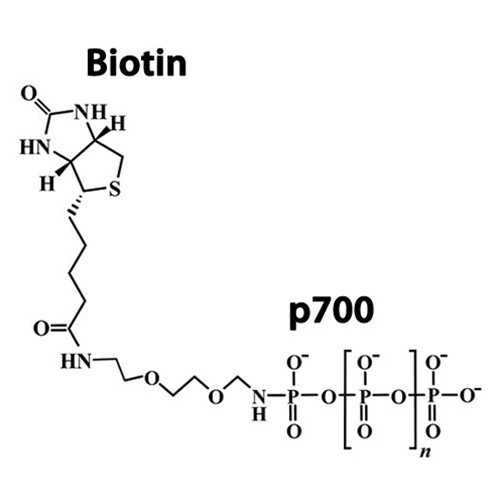Biotinylated Polyphosphate, Long Chain (p700)
This polyphosphate (Long Chain, Biotinylated) is heterogeneous in size, with approximate polymer lengths ranging from ~200-1300 phosphate units.
Highlights
- Contains biotin covalently attached to one or both of the terminal phosphates of the polyphosphate chain
- Can be immobilized on streptavidin-coated multiwell plates or beads for binding studies of proteins to polyphosphate
Polyphosphate, a linear polymer of inorganic orthophosphate, which is widespread in living organisms and which plays diverse roles in biology, has recently been shown to be a potent modulator of the human blood clotting system. Its procoagulant activity is dependent on polymer length; this high MW polyphosphate preparation has very high specific activity in plasma clotting assays.
In addition to being a useful tool for plasma clotting assays, polyphosphate is can be used to study bacterial growth, virulence, and bacterial membrane function.
Also available:
- Polyphosphate, Medium Chain (p100)
- Polyphosphate, Long Chain (p700)
- Biotinylated Polyphosphate, Medium Chain (p100)
From the laboratory of James H. Morrissey, PhD, University of Michigan.
This polyphosphate (Long Chain, Biotinylated) is heterogeneous in size, with approximate polymer lengths ranging from ~200-1300 phosphate units.
Highlights
- Contains biotin covalently attached to one or both of the terminal phosphates of the polyphosphate chain
- Can be immobilized on streptavidin-coated multiwell plates or beads for binding studies of proteins to polyphosphate
Polyphosphate, a linear polymer of inorganic orthophosphate, which is widespread in living organisms and which plays diverse roles in biology, has recently been shown to be a potent modulator of the human blood clotting system. Its procoagulant activity is dependent on polymer length; this high MW polyphosphate preparation has very high specific activity in plasma clotting assays.
In addition to being a useful tool for plasma clotting assays, polyphosphate is can be used to study bacterial growth, virulence, and bacterial membrane function.
Also available:
- Polyphosphate, Medium Chain (p100)
- Polyphosphate, Long Chain (p700)
- Biotinylated Polyphosphate, Medium Chain (p100)
From the laboratory of James H. Morrissey, PhD, University of Michigan.
Not seeing the size you're looking for? For custom sizes or bulk pricing, please contact us for a quote.
| Product Type: | Small Molecule |
| Name: | Polyphosphate, Long Chain (Biotinylated) |
| Chemical Formula: | (NaPO3)n[actual counterions may be Na &/or Li; nis approximately 900 to 1100] |
| Molecular Weight: | Heterogeneous; Number average ~100 kDa; Range ~8 kDa to 192 kDa |
| Format: | Lyophilized |
| Purity: | <1% monophosphate |
| Buffer: | 20 mM Hepes-NaOH pH 8.0, 5 mM EDTA |
| Solubility: | At least 100 mM in water; <1 mM in buffers containing divalent metals (make intermediate dilutions in divalent metal ion free buffers) |
| Concentration: | When reconstituted:10 mM (phosphate monomer) NOTE: To estimate the polymer concentration, divide the phosphate monomer concentration by the modal polymer length |
| Size Distribution: | Mode of n: 900-1100 (as measured by migration on PAGE) |
| Comments: | It is recommended to use ~10.2 ug of the biotin-polyphosphate to coat all wells of a streptavidin-coated 96-well plate. |
| Storage: |
Dry material should be stored at room temperature (or lower) with dessication. Once reconstituted: - Stable at least 12 hours at room temperature - Stable at least 72 hours at 4C - Store long-term at -80C - Aliquot for repeated use, avoiding repeated freeze-thaw cycles - Do not store in the presence of divalent metal ions |
| Shipped: | Ambient temperature |
Size Distribution

Polyphosphate has limited solubility in the presence of divalent metal ions, so make intermediate dilutions in water, or in buffers without divalent metals or polyphosphate-binding proteins.
Reconstitution:
1 - Centrifuge tube 1 min at 1000 x g to pellet material in bottom of tube.
2 - Reconstitute in 118 µL purified water to make a solution of 10 mM phosphate.
NOTE: May be reconstituted in larger volumes to make a more dilute solution as needed.
- Choi SC et al. Phosphoramidate end labeling of inorganic polyphosphates: facile manipulation of polyphosphate for investigating and modulating its biological activities. Biochemistry 49(45):9935-41, 2010.
- Smith SA et al. Inhibition of polyphosphate as a novel strategy for preventing thrombosis and inflammation. Blood 120(26):5103-10, 2012.
- Morrissey JH, Choi SH, and Smith S.A. Polyphosphate: an ancient molecule that links platelets, coagulation and inflammation. Blood 119:5972-5979, 2012.
- Rao NN, Gómez-García MR, and Kornberg A. Inorganic polyphosphate: essential for growth and survival. Annu Rev Biochem. 78:605-647, 2009.
- Dinarvand P, Hassanian SM, Qureshi SH, Manithody C, Eissenberg JC, Yang L, Rezaie AR. Polyphosphate amplifies proinflammatory responses of nuclear proteins through interaction with receptor for advanced glycation end products and P2Y1 purinergic receptor. Blood. 2014 Feb 6;123(6):935-45.
- Suess PM, Gomer RH. Extracellular polyphosphate inhibits proliferation in anautocrine negative feedback loop in Dictyostelium discoideum. J Biol Chem. 2016 Aug 12. pii: jbc.M116.737825. View Article
- Morrissey JH. Poly-P as Modulator of Hemostasis, Thrombosis, and Inflammation. Blood 2017 130:SCI-1.
- An J, Cho J. Potential immune-modulatory effects of wheat phytase on the performance of a mouse macrophage cell line, Raw 264.7, exposed to long-chain inorganic polyphosphate. Asian-Australas J Anim Sci. 2020 May 12. View article
If you publish research with this product, please let us know so we can cite your paper.


